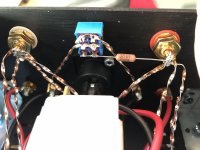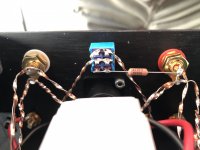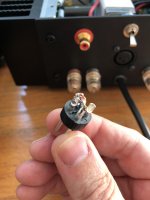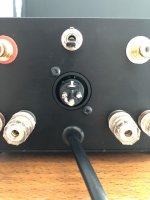I have been playing with ACA's recently, swapping between bridged mono and parallel mono operation... and then I realised that instead of having to do a fair bit to go from one configuration to another, there was a pretty capable rating-wise switch at the back that can do both in no time at all.
So, I took a few photos that explain what I did. The switch contacts should be used in parallel to half the contact resistance😉
I considered the safety as well... and could not see any problem in using the switch for either mode.
Especially useful if you want to try monoblock ACA in both modes at your friends' place, for example, where each mode may sound different depending on individual tastes, rest of the system, speakers, room size/damping...
Also, why settle for one mode, when you can change the mode to suit your mood... don't forget to re-wire speaker connections when changing the modes.
So, I took a few photos that explain what I did. The switch contacts should be used in parallel to half the contact resistance😉
I considered the safety as well... and could not see any problem in using the switch for either mode.
Especially useful if you want to try monoblock ACA in both modes at your friends' place, for example, where each mode may sound different depending on individual tastes, rest of the system, speakers, room size/damping...
Also, why settle for one mode, when you can change the mode to suit your mood... don't forget to re-wire speaker connections when changing the modes.
Attachments
They are monoblocks😉...
Switch is one position => bridged
Switch in the other position => parallel
Switch is one position => bridged
Switch in the other position => parallel
That is a clever solution

Thanks! Much appreciated, knowing that it comes from you!!
Nick
Hey, cool hookup wire! What is it? Diy? Looks like Alpha/Goertz without the pvc.
The wire is a combination of pure copper ribbon and a pure silver ribbon. I also use silver-plated pure copper, solid core.... silver and then gold plated pure copper, solid core. For tube gear, few silver ribbons annealed, are simply stunning. I use wider ribbons (copper/silver) for mains and speaker signals.
Litz wire I tend not to use at all.
that switch?
Please excuse my ignorance, but...
I was just on the lookout for information about wether it is ok to have any switch of sorts in the signal-path, and this ACA of yours seems to be a good example, since you are using quite exquisite wiring-materials...
So, does it really not matter what switch to use (in this position)... ... shouldn't there be some kind of more ... well, you know, high-endy part?
thanks!
david😕
Please excuse my ignorance, but...
I was just on the lookout for information about wether it is ok to have any switch of sorts in the signal-path, and this ACA of yours seems to be a good example, since you are using quite exquisite wiring-materials...
So, does it really not matter what switch to use (in this position)... ... shouldn't there be some kind of more ... well, you know, high-endy part?
thanks!
david😕
Monoblock ACA bridged mono <=> parallel mono at the flick of a switch
Zen Mod, I‘m not in Sound, I‘m ... clueless but fascinated
if in doubt , use Takamisawa relay
🙂
Zen Mod, I‘m not in Sound, I‘m ... clueless but fascinated
The switch is pretty good for the purpose... it is rated for mains voltage use, and I mentioned already how to utilise both contacts for each position, to halve/minimise contact resistance. The switch option provides for an easy change of the mode of operation while playing/deciding on which mode suits your needs best. Once you settle on either, there's nothing to stop you from omitting the switch and hard-wiring for the chosen mode of operation.
The bridged mono mode requires high-quality signal relays, the paralleled mono operation requires high current -capable split relay contacts.... but relay options are too cumbersome because they'll require some sort of control circuitry to operate them in the correct way.
The little ACA already comes with the switch.... so it's simple to implement and use for both modes.... just don't forget to us both switch contacts for either position
Whenever there's more than one option, there's a compromise -> some sort of switching method has to be utilised
The bridged mono mode requires high-quality signal relays, the paralleled mono operation requires high current -capable split relay contacts.... but relay options are too cumbersome because they'll require some sort of control circuitry to operate them in the correct way.
The little ACA already comes with the switch.... so it's simple to implement and use for both modes.... just don't forget to us both switch contacts for either position
Whenever there's more than one option, there's a compromise -> some sort of switching method has to be utilised
Last edited:
And actually you can control fancy relays with a crappy switch. No control circuitry. And for some uses it allows you to put the switch on the front panel without a long signal run
Yeah. Brilliant.
The little ACA already comes with the switch.... so it's simple to implement and use for both modes.... just don't forget to us both switch contacts for either position
Um, doesn’t the build guide already show how to use the switch for this?
Last edited:
Make sure, if you use the ribbon approach, that you run both ribbons to the same place. If you split the cable at the end and connect each ribbon to a different place(i.e. in an interconnect or any other AC signal) that is absolute worst case for capacitance which will have a negative effect on high frequencies.Thanks. Are ribbons of such small width readily available or do you cut them yourself?
- Home
- Amplifiers
- Pass Labs
- Monoblock ACA bridged mono <=> parallel mono at the flick of a switch



